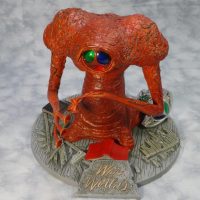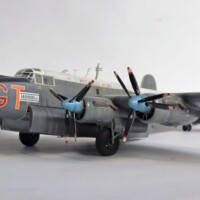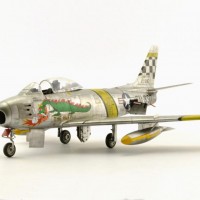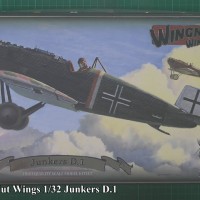Hobbycraft 1/72 F2H-3 Banshee
With its name derived from Irish mythology, the McDonnell F2H Banshee was an early jet fighter operated by the United States Navy, the United States Marine Corps and the Royal Canadian Navy.
The Banshee was developed during the mid to late 1940s, being a larger, more powerful and more heavily armed derivative of the earlier FH Phantom and incorporating several innovations, such as a pressurized cockpit, a "kneeling" nose landing gear and an ejection seat.
Albeit (mainly due to its straight wing) being considerably slower than the latest land-based fighters, with its powerful twin jets, its high rate of climb, its ruggedness and resistance to flak and easy maintainability it proved to be a capable high-altitude fighter, making it the aircraft of choice to escort B-29 bombers over Korea. In total, 895 examples were built.
In 1951, the Royal Canadian Navy (RCN) drafted a $40 million deal for 60 new Banshees to replace its obsolete fleet of Hawker Sea Furies.
Although initially well-liked by Canadian pilots for its flying qualities, the Banshee exhibited a high accident rate of 30.8%.
The short lived Canadian Banshees were the primary aircraft of the equally short-lived RCN Grey Ghosts aerobatic team that flew available operational Banshees for each show.
This is the late 80s Hobbycraft mold that has lately been recently reissued by Academy. Essentially an upgrade of the older Airfix offering, it is a solid kit, providing a decent representation of the F2H-3, having its strong points (sharp molding, well done engraved panel lines, looks accurate) and lacking at areas like the too shallow wheel wells and the off-registered decals at the earlier reboxings, with the detail at the rest key areas (like the cockpit, engine and landing gear parts) being average.
https://modelingmadness.com/review/korean/us/usn/Fighter/penban.htm
Happy Modelling!


















Excellent work and a nice obscure aircraft this time. As an aircraft it looks a bit underpowered though.
Thank you kindly, my friend @christopher!
Really nice job on this beauty Stelios, well done.
Thank you kindly, my friend @neil-foster!
This is a solid kit. If you can get a Obscureco resin cockpit you can really build a nice model. Yours looks great Spiros!
Thank you very much, my friend @angus64!
Another great example of your ability to make an old kit look bang up to date, Spiros.
Thank you kindly, my friend @chinesegeorge!
Beauty. Would loved a good Banshee in 1:48
Thanks a lot, my friend @blackadder57!
Yes, a good quarter scale Banshee is highly desirable!
Spiros: This model is exceptional, showing off your excellent modelling skills.
A few years back, I had the distinct pleasure of seeing one of these Canadian F2H-3 Banshees, located in a small museum in Calgary, Alberta, Canada. It was really neat to see this historic aircraft (but the aircraft was hard to see because it was inside a small space with lots of other exhibits surrounding it. Still, it was nice to see. Your model certainly lcaptures the look of the real thing.
Great job!
Thank you kindly, my friend @marvin!
Wish I were lucky enough to see a Banshee in real.
Great job, Spiros. Always partial to a Canadian scheme.
Thank you very much, my friend @gwskat!
@fiveten - Fantastic build and an excellent writeup Spiros! The paint and weathering look amazing.
Thank you very much, my friend @brithebuilder!
Very nice result on this Banshee, Spiros @fiveten
Supported with a nice to read article as well.
Never knew this aircraft was even used in an aerobatic team.
Thank you so much, my friend @johnb!
Great work as usual Spiros @fiveten. I got to see an RCN Banshee at the Canadian Aviation Museum in Ottawa, and it had me thinking of your build. Thanks for contributing to the RCAF group build.
3 attached images. Click to enlarge.
Thanks a lot, my friend @aldog! The pleasure is mine, in fact Ibam honored to be a participant in this wonderful GB!
Great Banshee pics!
Nice completion, Spiros. Great looking Banshee.
Which reminds me - I gotta get to an addition to Aldo's 100 year CAF group.
Thanks a lot, my friend @georgeswork! Looking forward to your entry!
Nice Banjo Spiros, that's not kit seat, is it? one of the Phantoms ancestors, if you study McDonnell's other aircraft you see design lines in the F-88 and F-101.
Thanks a lot, my friend @roofrat! This is the kit seat with a few scratchbuilt extras.
I did a USN {VF-31} of the same kit awhile back, it' s amazing it's the same seat, nice work.
Thanks again, my friend @roofrat!
Ah - I never knew the Canadians flew the Banshee! Looks fantastic in those colors - more interesting than the usual dark blue monochromatic scheme. Great work!
Thank you kindly, my friend @gkittinger!
A beautiful model, Spiros; I like it indeed!
Thank you kindly, my friend @rosachsenhofer!
She's a beauty, Spiros. Nice job on the build and overall finish.
Thanks a lot, my friend @v1pro!
Nice work, Spiros! Glad to see this one turn out so well.
Thanks a lot, my friend @j-healy!
Nice looking Banshee Spiros, Additional points for the Canadian content as I always appreciate that Hopefully I will be able to get a 1/48th scale example into my collection at some point - Cheers
Hopefully I will be able to get a 1/48th scale example into my collection at some point - Cheers
Thank you so much, my friend @flypastrush!
Just joining to say what has already been made obvious: great looking plane, excellent model!
Thank you kindly, my friend @marcellorosa1!